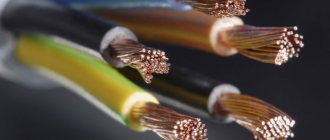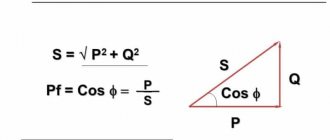What it is
A portable device designed to monitor the presence or absence of voltage in the electrical network and live parts of electrical installations is called a voltage indicator. This device is used before connecting portable grounding and starting electrical installation work. In this case, there is no need to find out the voltage value, you only need to know its presence or absence.
Voltage indicator.
The life of the installer depends on this device, since its readings indicate the presence of voltage. Only after making sure that the latter is absent from live areas can you begin repair work.
Types of voltage indicator screwdrivers and rules for using them
It is impossible to imagine the economic activity of any enterprise and running a household without electricity. Electric energy is necessary for the efficient operation of equipment, appliances, large and small household appliances. wiring often leads to various types of faults. In one case, home appliances and household appliances will stop due to a lack of mains voltage. And in another situation, a fire may start, the source of ignition of which may be sparkling switches, sockets, extension cords, as well as failed artificial lighting sources. To solve this kind of problems with power supply in houses and apartments, the services of professional electricians are needed. For a fee, they will be able to eliminate any wiring problems and restore comfortable housekeeping conditions. But most breakdowns can be fixed with your own hands. A voltage indicator, also called an indicator screwdriver or an indicator screwdriver, is mainly used to determine whether there is voltage on a section of the network or not. This will ensure safety during electrical repair work, connecting household appliances, and troubleshooting problems caused by a power outage. With its help, determining zero and phase in the network is not difficult. Fixing power supply problems yourself is a rational, cost-effective solution that allows you to save money on paying for electrician services.
Options
Manufacturers of such devices must comply with certain technical specifications, a full list of which is specified in the state standard. The most important ones include the following:
- signals (sound, light) are clearly defined, the duration of the interval between pulses is no more than 1 s, the indicator load reading does not exceed 50 V;
- a single-pole pointer consists of 1 body, on which there is an electrode tip, on the handle - a contact point for the user’s finger;
- bipolar devices have two separate shells, which are connected by a wire (1 m) and are equipped with separate working electrodes with an open tip (does not exceed 7 mm).
Voltage indicators may have additional functions: checking network integrity, determining polarity, locating a phase conductor. The main condition for increasing the capabilities of the device is safety of use when performing basic functions. On the eve of work, the pointer is checked with a potential of 2 kV, which is turned on for 1 minute.
Types of indicator screwdrivers, their design
Depending on the design, principle of operation, and the presence of additional functions, all models of these devices are divided into simple, with a built-in battery, contactless and electronic.
Plain (simple) with neon lamp
Simple indicator screwdriver
The simplest tester of this type consists of:
- Cases made of transparent, bright plastic;
- Flat-tipped stings;
- Resistor (resistance) with a nominal value of 1 mOhm;
- Neon lamp;
- Contact area.
For more comfortable wearing, a spring clip is attached to the upper part of the case.
Battery-powered indicator screwdriver (with dialing function) contact type
Battery tester
In appearance, this tester is very similar to the previous one. Its difference lies in the fact that the tip is connected to the gate of the field-effect transistor; instead of a neon lamp, this device uses an LED. To power the LED, 2 replaceable watch batteries of 1.5 V each are placed in the case.
Non-contact voltage testers
Non-contact tester
A non-contact tester is a device similar in shape and size to a marker. The main working part of this device is the sensor, covered with a white cap with a short and round tip. This tester runs on 2 AAA batteries (2 small AA batteries).
Some models have a small LED for illumination near the tip for ease of use.
Electronic or smart indicators
Electronic indicator screwdriver
An electronic screwdriver tester is an indicator consisting of a short flat tip, an opaque body, a small liquid crystal display, and two small contact pads (pole buttons).
On a note. In addition to these types, there is also a voltage indicator such as a screwdriver probe, consisting of two probes connected by wire, one of which has LEDs indicating a certain voltage value (from 5 to 220-360V).
How does it work
All objects contain electrical charges: anions, cations, electrons. Their number affects the value of the negative or positive potential. The difference between these values is the voltage, after which the movement of charges appears (electrical current). This property was used in the development of devices for searching potential:
- a resistance is placed in the path of the particles, which reduces their concentration to a minimum (safe for people);
- residual electricity is converted into light, sound or magnetic energy;
- the intensity of the received signal indicates the absence or presence of potential.
You might be interested in this Description of the DT9205A multimeter
The device is connected to the network using contacts or terminals and the presence or absence of electric current is determined. When voltage exists, this is indicated by the sound of a microspeaker, a meter needle, or an LED light bulb.
Carrying out measuring work
Varieties
Electrical goods stores sell several types of single-pole devices: a simple screwdriver with an indicator (neon lamp), a screwdriver with a battery, and a multifunctional test screwdriver. They differ in their capabilities and the method of signal delivery (light or sound):
- Simple screwdriver indicators with a neon light bulb. They consist of a metal probe (tip), a plastic housing, a high-resistance resistor, a neon light element and a contact metal plate placed on the head. The device of the indicator screwdriver is the simplest. It detects only the phase wire, as well as the presence of voltage. The positive aspects of such devices are their ease of use, no batteries, and reliability. How to use an indicator screwdriver? Everything is very simple. You just need to touch the bare wire or socket hole with the sting, and touch the plate on the handle with your finger. If there is voltage in the circuit, current will flow through the tip, the resistor, the light bulb (causing it to glow), and the human body, which will become part of the circuit when a finger touches the contact on the handle. If you remove your finger from the contact, the light will go out. If there is no voltage or the wiring is damaged, the tester screwdriver will not light up.
- Indicator screwdrivers with batteries and LED elements. Externally, these devices are similar to previous devices with a slight difference: you can find the phase wire without touching the contact plate at the end of the screwdriver. In addition, with such a device you can ring electrical wiring for breaks. To do this, touch one end of the chain with a sting contact, touch the other end of the chain with your hand, and touch the contact on the tester head with your finger. If the circuit is working properly, the LED element will begin to glow. An indicator screwdriver with a battery costs a little more than a regular one.
Advanced indicator screwdrivers. Devices with more functions and more complex filling, but still distinguished by the same principle of operation of an indicator screwdriver. They allow you not only to determine the phase or ring the wires, but are also suitable for non-contact detection of hidden wiring under a small layer of finishing material. Due to the high sensitivity of the devices, it is possible to determine the phase through one insulating layer of insulation without damaging it. They are inexpensive, accurate, simple and easy to use. For example, an excellent choice for home electrical work would be the Safeline MS-18 indicator screwdriver. This device will allow you to easily determine the presence of alternating voltage up to 250V by contact method (it can detect phase and neutral wires). It can also be used for a non-contact method of detecting hidden wiring (up to 600 V). It is capable of finding the location of a wire break in a non-contact manner, ringing the circuit, and also establishing the polarity of a battery or accumulator (up to 36 V). With so many functions, the model is inexpensive (on average 250 rubles). To select test modes (contact/non-contact), the indicator screwdriver is equipped with a switch. Such devices will become universal “detectors” of wire breaks under a layer of finishing material. Their circuit has both a light and a sound indicator. If necessary, the multifunctional indicator screwdriver can be adjusted for specific types of work.
How to check for damage to wires hidden in the wall? An indicator electronic screwdriver is used for this. Having turned it on and set the switch to non-contact mode, you need to slowly move the tip of the test screwdriver along the wall along the route along which the wires run from the junction box to the switch or socket. Where the cable is damaged, the indicator light will go out.
Most models of indicator screwdrivers are inexpensive. The functionality is quite sufficient for testing electrical circuits at home.
Kinds
In order to select the most suitable tool for work under certain conditions, you should know the range of manufactured devices. All of them are divided into groups according to different criteria:
- Based on the type of electric current being measured - to perform work with alternating and direct voltage circuits.
- By contact with live elements - contact, non-contact.
- By the number of contacts - single-pole, double-pole. The latter type is considered universal, since it is used to determine the presence of potential in all circuits. The action is based on the passage of electrons. Single-pole devices use the properties of capacitive electric current. They are only suitable for measuring work in variable networks.
- By type of indicator - LED, digital.
LED indicator
The devices also differ in appearance and measurement range. The amount of voltage that is allowed for operation is indicated on the body of the tool. Using a 220 V indicator in a 0.4 kV electrical network poses a danger to life.
Digital indicator
Single pole
This low voltage indicator has one plus. To determine the presence of voltage, you just need to touch this pole with a current-carrying area. In this case, the ground connection flows through the user (his body) when he touches the contact on the tool. At this time, a small current appears, not exceeding 0.3 mA, and the light bulb lights up.
A device with one pole is used only to test alternating current. In the case of constant, the neon light will not light up even in the presence of voltage. It makes sense to use a single-pole device when checking phase wires, phases in switches, sockets or sockets, as well as in other similar places.
Single-pole device
The voltage indicator up to 1000 V can be used without rubber gloves or other protective equipment. According to safety rules, it is not recommended to use a test lamp screwed into a socket instead of a voltage indicator. If by chance there is a high voltage supply to this bulb or any damage occurs, the bulb bulb may burst. As a result, the electrician will be injured.
You might be interested in this: Working with a dt 832 multimeter
The main disadvantage of single-pole devices is their low sensitivity. The presence of voltage is shown only from 90 V.
Bipolar
Monitoring the presence or absence of voltage using a bipolar device is performed by touching 2 areas of the device, between which voltage is possible. If it is present, the neon light will light up (after current passes through it). It is worth noting that the latter is determined by the potential difference between the elements of the device touched by the indicator.
The current passing through the light bulb is characterized by a low value. But this is enough for a stable light signal. Connecting a resistor in series to the lamp limits the increase in electric current.
Two-pole device
LEDs of different shades, digital indicators, and light bulbs (neon) are used for the signal. It is worth recalling the combined indicators: in addition to the glow, they also have a sound signal. This improves the safety of using the device.
The most popular two-pole voltage indicator up to 1000V is an ordinary multimeter. It determines the magnitude of the potential of both direct and alternating current, the value of its frequency and strength. This type of tool is indispensable in everyday life.
Multimeter
Single-pole probe
Used only in alternating current circuits with voltage up to 1 kV. Requires touching the equipment at one point. The circuit is closed through a person to the ground. The glow of the indicator causes capacitive current to flow.
Designed to test secondary switching nodes. With its help, you can detect the phase in conductors or on the components of any low-voltage electrical equipment, including household ones. Most often used when working with lighting, checking cartridges, switches, and phrasing the electric meter.
The most common design is in the form of a screwdriver or pen. Allows you to check the presence or absence of phase voltage. The housing is made of transparent dielectric material. It contains the details of the device:
- pin - screwdriver;
- gas discharge lamp - indicator with an ignition threshold of up to 90 volts;
- a 1MΩ resistor connected in series provides a safe current value (about 0.5mA) sufficient for the indicator to light;
- spring - ensures reliable contact between all parts;
- end contact for finger contact.
The following indicators are produced under the names: INO-70, IN-90, IN-91 and others. The disadvantage of these devices is low sensitivity and susceptibility to interference from nearby electrical wiring.
Voltage indicator design
Voltage indicators of different types differ to some extent in their design. The main ones are presented below.
- Single pole. In most cases, it is made in the form of a handle, a screwdriver made of transparent material (which does not conduct current). In addition, models with a viewing window are available. The design contains a resistor and a neon lamp. In the lower body part there is a spring and a probe, on top there is a contact point for touching.
Single-pole voltage indicator device.
- Bipolar. Includes two separate parts made of non-conductive material and soft insulated copper wire. The latter connects both elements. A neon light bulb is bridged using a resistance. This method reduces the susceptibility of the instrument to the influence of induced voltage. These types of indicators have a built-in special scale designed for certain voltage values (from 12 to 750 V).
Design of a two-pole voltage indicator
- Contactless. The presence of voltage is checked without connecting to live terminals, which significantly increases safety during the period of measurement work. The indicator has a digital display, which shows not only the occurrence of voltage, but also the approximate value due to the help of the magnetic field. Non-contact indicators are designed to search for live wires, including those hidden in walls and panels. A device of this type responds to an alternating field.
You may be interested in this The best models of welding machines
Non-contact tool
Voltage control should always be performed carefully and accurately, and be sure to strictly follow the safety instructions. Such measuring work is unsafe for human life.
High voltage device (more than 1 kV)
High voltage indicators operate due to the effect that occurs from the glow of neon when a capacitive current flows through the lamp of a capacitor, which is connected in series with it.
What problems does a multifunctional voltage and current relay solve?How to choose an electrical panel housing for your home?
- Electrical network design
An indicator of this type is called high-voltage and it is suitable for checking alternating voltage, while touching only the phase, there is no place for contact with the finger.
All models have different design features, but have elements common to all.
In accordance with the requirements of electrical safety rules:
- work must be carried out wearing rubber hand protection, the pointer must be in good technical condition, which must be checked in advance;
- It is prohibited to ground the indicator to prevent possible contact with live parts, which could lead to injury to the electrician.
Requirements for pointers
The general list of requirements for the use of UN includes compliance with the stated technical characteristics according to GOST, verification, which includes visual inspection, resistance to mechanical and climatic influences, electrical insulation resistance, accurate operation of the charger, compliance with working drawings, presence of roughness, complete set of all components (especially the restrictive ring), the presence of a certificate and accompanying documents (diagrams, instructions, memos, etc.).
Visual inspection consists of inspecting and checking serviceability, completeness, integrity of packaging, presence of markings and corrosion protection. Compliance with the working drawing is carried out using measuring tools. The surface is checked for the presence of roughness using an optical indicator or profilometer. If the product body is made of metal, then it must be made in accordance with GOST 9.302.
Also read: Under what conditions is parallel operation of transformers allowed?
The unit must be in good working order, without external damage, with working light and sound signals, and the insulating parts must have dielectric properties. The current value must be indicated in the technical data sheet. Only if such requirements are met is the device permitted to be used.
IMPORTANT! All UN have a production test report and a safety certificate issued by the authorized bodies of the Russian Federation. The tested device has a tag with a stamp with the verification date.











